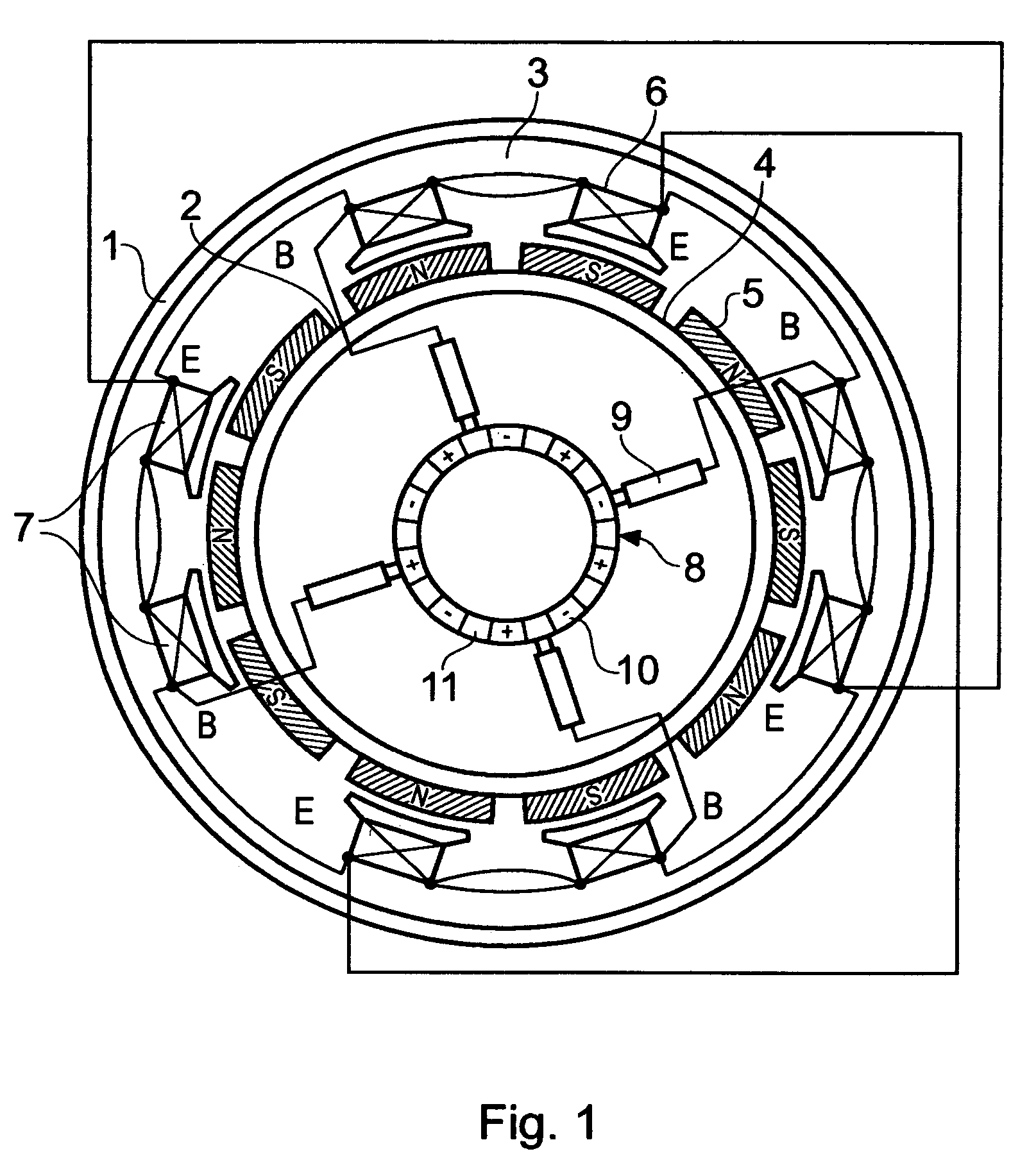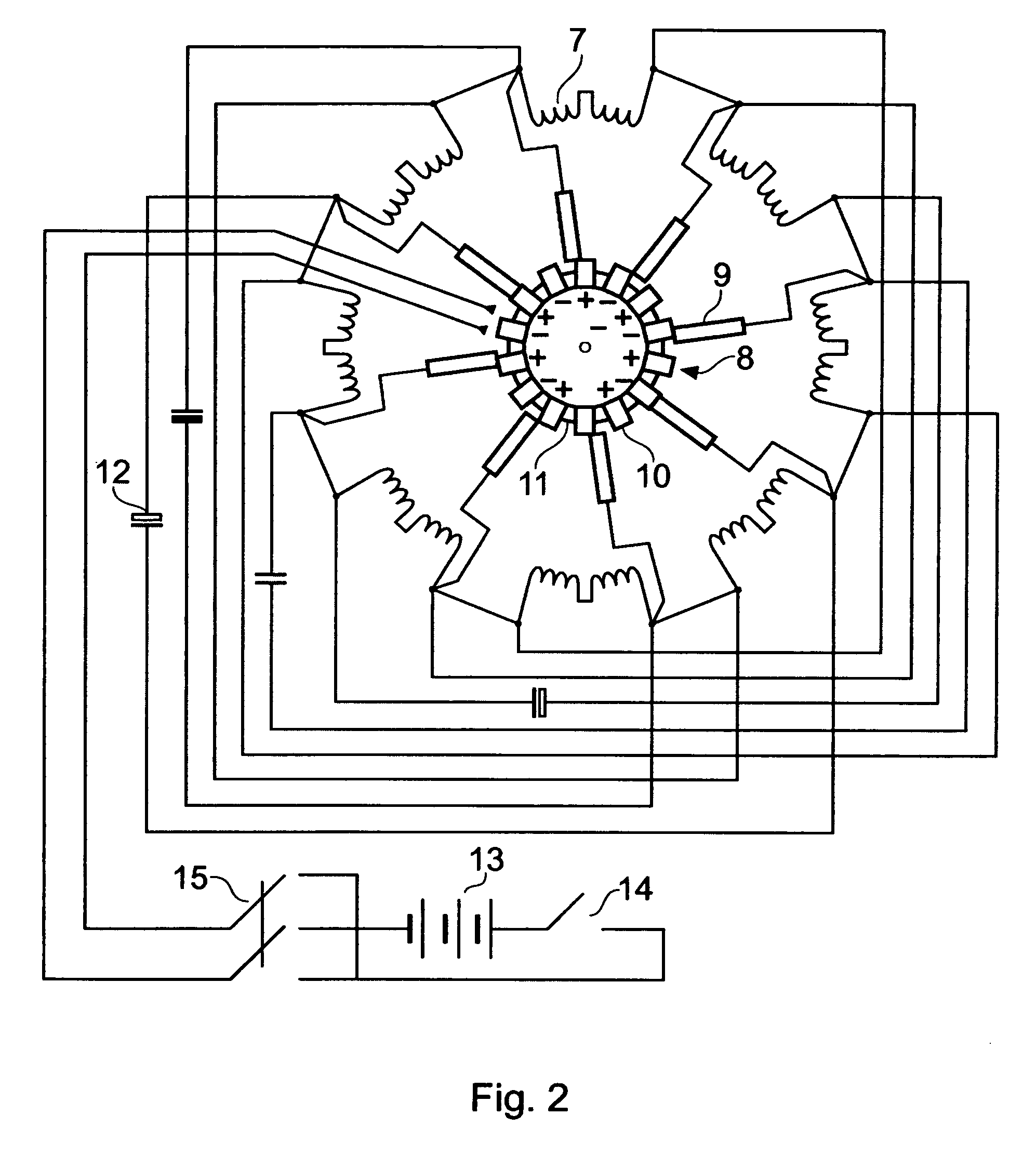Pulsed-inertial electric motor
a technology of electric motors and electric motors, applied in mechanical energy handling, transportation and packaging, windings, etc., can solve the problems of complex control system and high-voltage power supply, motor-wheels offering no prospects for electric energy recovery, and high heat evolution, so as to improve the performance characteristics, simple design, and high reliability
- Summary
- Abstract
- Description
- Claims
- Application Information
AI Technical Summary
Benefits of technology
Problems solved by technology
Method used
Image
Examples
example 1
[0040]A prototype electric motor was constructed with a stator involving 22 permanent magnets, a rotor involving three pairs of electromagnets, and the coils in each electromagnet containing 68 turns of an 1.06-diam wire. The motor has the following parameters: diameter, 300 mm; width 50 mm; weight, 7.5 kg; power consumption, 240 W; supply voltage, 24 V; torque, 9.6 N / m.
[0041]This motor was used as a motor-wheel in a bicycle of the STELS type with 26″ wheels. The current source comprised a pair of 12-V storage batteries, each with a capacity of 20 A / h. The bicycle with an electric drive based on the proposed motor was tested to show the following characteristics: weight-carrying capacity, 120 kg; cruising speed, 25 km / h; maximum run (for a storage battery discharged to 10.5 V), 40 km.
example 2
[0042]A prototype electric motor was constructed with a stator involving 22 permanent magnets, a rotor involving five pairs of electromagnets, and the coils in each electromagnet containing 50 turns of an 1.25-diam wire. The motor has the following parameters: diameter, 300 mm; width 60 mm; weight, 9.6 kg; power consumption, 1000 W; supply voltage, 48 V; torque, 40 N / m.
[0043]This motor was used as a motor-wheel in a scooter type with 16″ motorcycle wheels. The current source comprised four 12-V storage batteries, each with a capacity of 20 A / h. The scoter with an electric drive based on the proposed motor was tested to show the following characteristics: weight-carrying capacity, 150 kg; cruising speed, 45 km / h; maximum speed, 60 km / h; maximum run (for a storage battery discharged to 10.5 V), 50 km.
example 3
[0044]A prototype electric motor was constructed with a stator involving 18 permanent magnets, a rotor involving four pairs of electromagnets, and the coils in each electromagnet containing 55 turns of an 1.32-diam wire. The motor has the following parameters: diameter, 306 mm; width 72 mm; weight, 11 kg; power consumption, 1500 W; supply voltage, 48 V; torque, 52 N / m.
[0045]Two such motors were used as motor-wheels in a three-wheel carriage with 16″ motorcycle wheels for a driver and two passengers. The current source comprised four 12-V storage batteries, each with a capacity of 60 A / h. The carriage with an electric drive based on the proposed motor was tested to show the following characteristics: weight-carrying capacity, 500 kg; cruising speed, 45 km / h; maximum speed, 70 km / h; maximum run (for a storage battery discharged to 10.5 V), 70 km.
[0046]All measurements disclosed herein are at standard temperature and pressure, at sea level on Earth, unless indicated otherwise.
PUM
 Login to View More
Login to View More Abstract
Description
Claims
Application Information
 Login to View More
Login to View More - R&D
- Intellectual Property
- Life Sciences
- Materials
- Tech Scout
- Unparalleled Data Quality
- Higher Quality Content
- 60% Fewer Hallucinations
Browse by: Latest US Patents, China's latest patents, Technical Efficacy Thesaurus, Application Domain, Technology Topic, Popular Technical Reports.
© 2025 PatSnap. All rights reserved.Legal|Privacy policy|Modern Slavery Act Transparency Statement|Sitemap|About US| Contact US: help@patsnap.com



